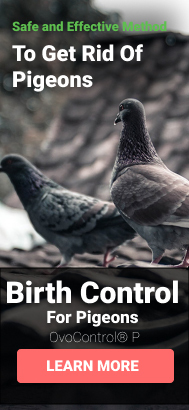Bird Control Methods for Hospitals and Healthcare Facilities
Written by Erick Wolf
Hospital bird control must be of utmost priority for healthcare facilities to avoid pest bird infestations. Pest birds can play host to scores of internal parasites and infectious diseases, but medical facilities are supposed to make people well. With effective bird control for hospital facilities, you can help protect your frontline care workers and patients.
In this article, we’ll take an in-depth look at medical centers' bird control, including discussing why it’s important and identifying some of the most prevalent healthcare bird control methods available today.
Why is Hospital Bird Control Important?
Hospital bird control is crucial to facilities worldwide as birds have plagued the healthcare industry since the beginning of time.
Costly Damages and High Repair Costs
For starters, the acidic nature of bird droppings is notorious for undermining, deteriorating, and damaging the structural integrity of healthcare facilities. Pest birds can do considerable damage to hospital buildings, including:
Bird droppings freezing up windows meant to open and provide fresh air
Nesting debris clogs rain gutters and causes roof leaks
Bird droppings are eating away at glass, plastic, vinyl, aluminum, and steel surfaces
Nesting debris interfering with security cameras, light fixtures, signage, solar panels, skylights, and AC vents
Health Hazards for Patients and Workers
Hospitals must take extra care in medical facility bird control to avoid pest bird infestations. Bird droppings can carry any of 60 known diseases, including:
West Nile virus
Toxoplasmosis
Meningitis
Salmonella
Encephalitis
Histoplasmosis
Extra Cleaning Costs
You can save countless hours and dollars spent cleaning corrosive bird droppings by eliminating the source. Rather than paying a cleaning team throughout the year, make the investment upfront to discover reliable healthcare facility bird control.
Reputation Damage
In addition to losing money to fixing damages due to corrosion, birds can cause potential liabilities by damaging the reputation of a well-established healthcare facility. It’s always best to minimize your weaknesses to the best of your abilities by focusing on healthcare facilities’ bird control.
Mess Created by Birds in Parking Lots
As a business owner, promoting safety should always be front of mind. That’s why hospital bird control is pivotal in increasing your patrons' and employees' health and safety. Bird droppings can also be responsible for potential slips and falls due to messes created by pests birds in parking lots.
Proven Hospital Bird Control Strategies
Here are the most popular hospital bird control methods available today.
Birth Control
When it comes to bird control for hospital buildings, birth control is the most humane option available. It limits the flocks' capability to multiply at rapid, uncontrollable rates rather than directly attacking the live population.
Bird Netting
One of the oldest forms of hospital bird control is bird netting. This mesh creates a physical barrier to prevent birds from landing or nesting near otherwise appealing areas. Although bird netting can be generally effective in hospital facilities, there are better solutions for larger, more extensive structures.
Bird Spikes
Bird spikes are another healthcare facility bird control method with various splay widths, ranging from one to ten inches. Spikes work to help keep birds away from specific areas of public property, but birds will undoubtedly find a way to rest in other locations whenever possible.
Bird Hazers
Bird hazers are a more practical option for protecting large open areas found in larger medical centers. Hazers work by emitting a light haze and scent irritating to birds as a more environmentally friendly alternative, often coming with solar-powered generator options. While bird hazers are a better alternative for large-scale healthcare bird control methods, they can be limited during inclement weather conditions.
Bird Deterrent Sound System
Using auditory stimuli to scare away birds, acoustic devices in the form of bird deterrent sound systems are another hospital bird control option. Powerful electronic noise repellers work in these systems to frighten away birds and protect up to 6 acres of land.
Other options include sound systems that emit a pre-recorded distress and predator call. These calls work against 22 species of birds, intimidating them away from otherwise attractive perching locations.
Electric Bird Deterrents
Electric bird deterrents use a strong contrast between a laser beam and ambient light to scare birds away. Avian dispersal lasers can startle birds and keep them away from hospital buildings.
While lasers work as a safer alternative to hospital bird control methods, they are limited during conditions with lighter ambient lighting. Additionally, laser bird deterrents tend to be highly species-specific.
Why Use Ovocontrol in Hospital Bird Control
When it comes to finding effective hospital bird control methods, you’ll often find that it requires multiple options to get the job done. For larger, more extensive facilities, you might have to get creative and be highly flexible with your budget. Thankfully, OvoControl is the new solution to bird control for healthcare facilities and buildings.
OvoControl is an edible, kibble-type bird birth control. Thinking it is food, birds consume OvoControl, which has a state-of-the-art formula strictly limiting the ability of a pigeon’s egg to develop fully.
Final Thoughts
While there are a few different options for hospital bird control, they often require multiple solutions and can still only partially be effective at minimizing damages and costs.
OvoControl remains one of the most humane and practical solutions to bird control for healthcare facilities today. Its multiple delivery options make it customizable to any bird population size, while its non-toxic active ingredient ensures humane treatment of the birds.





